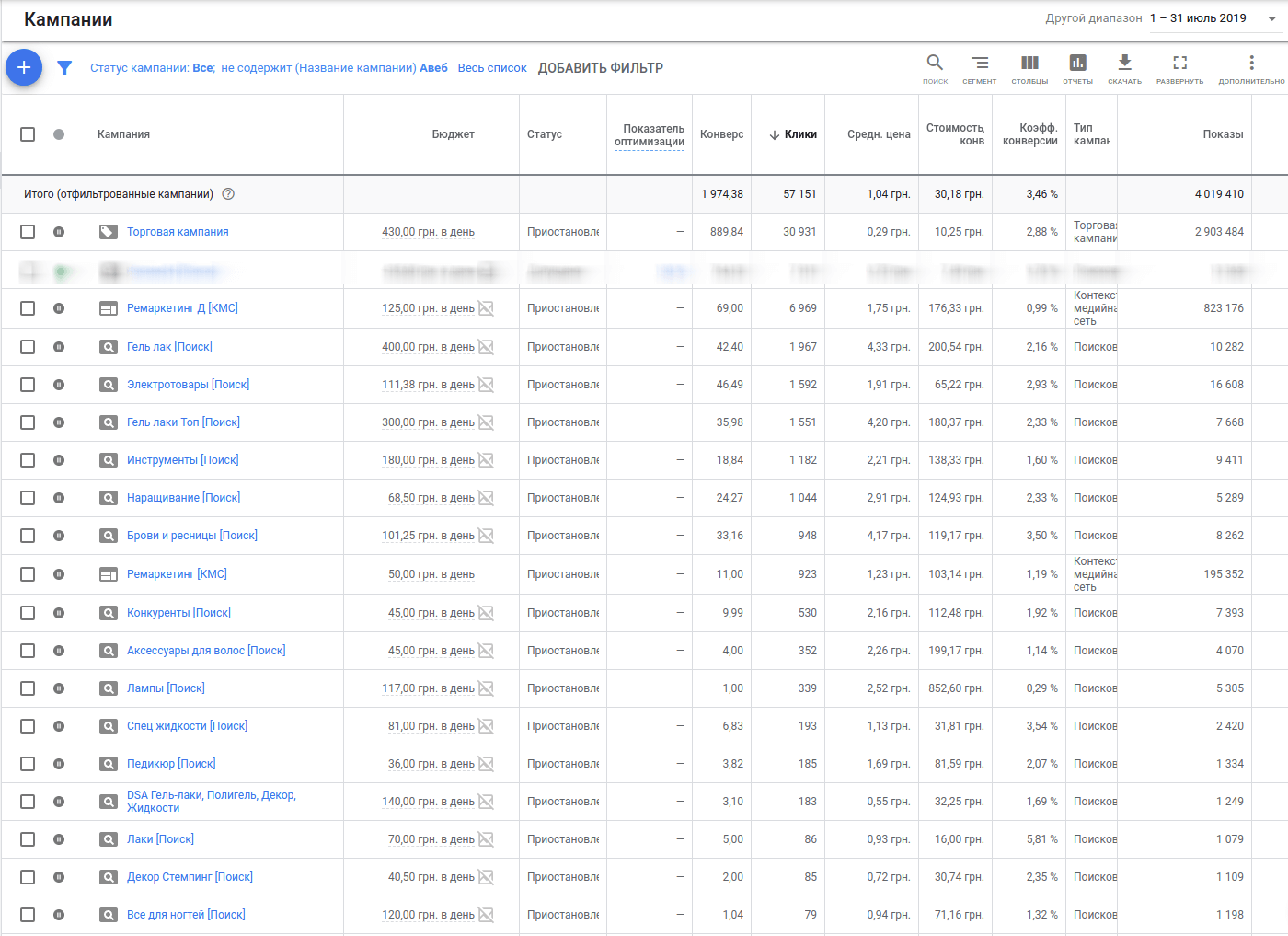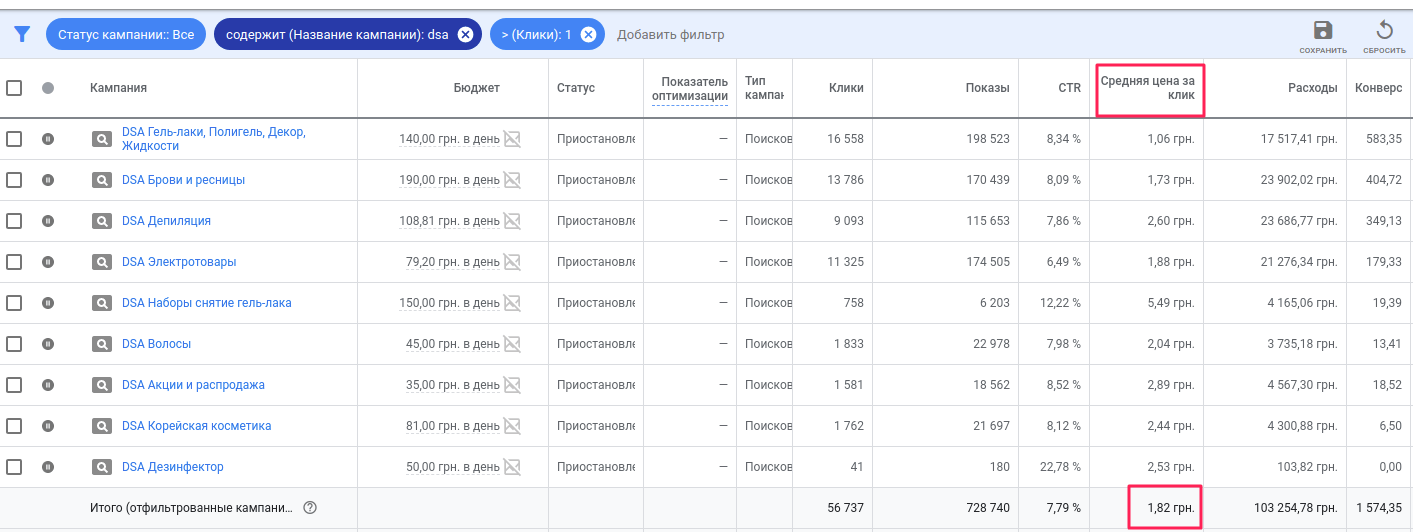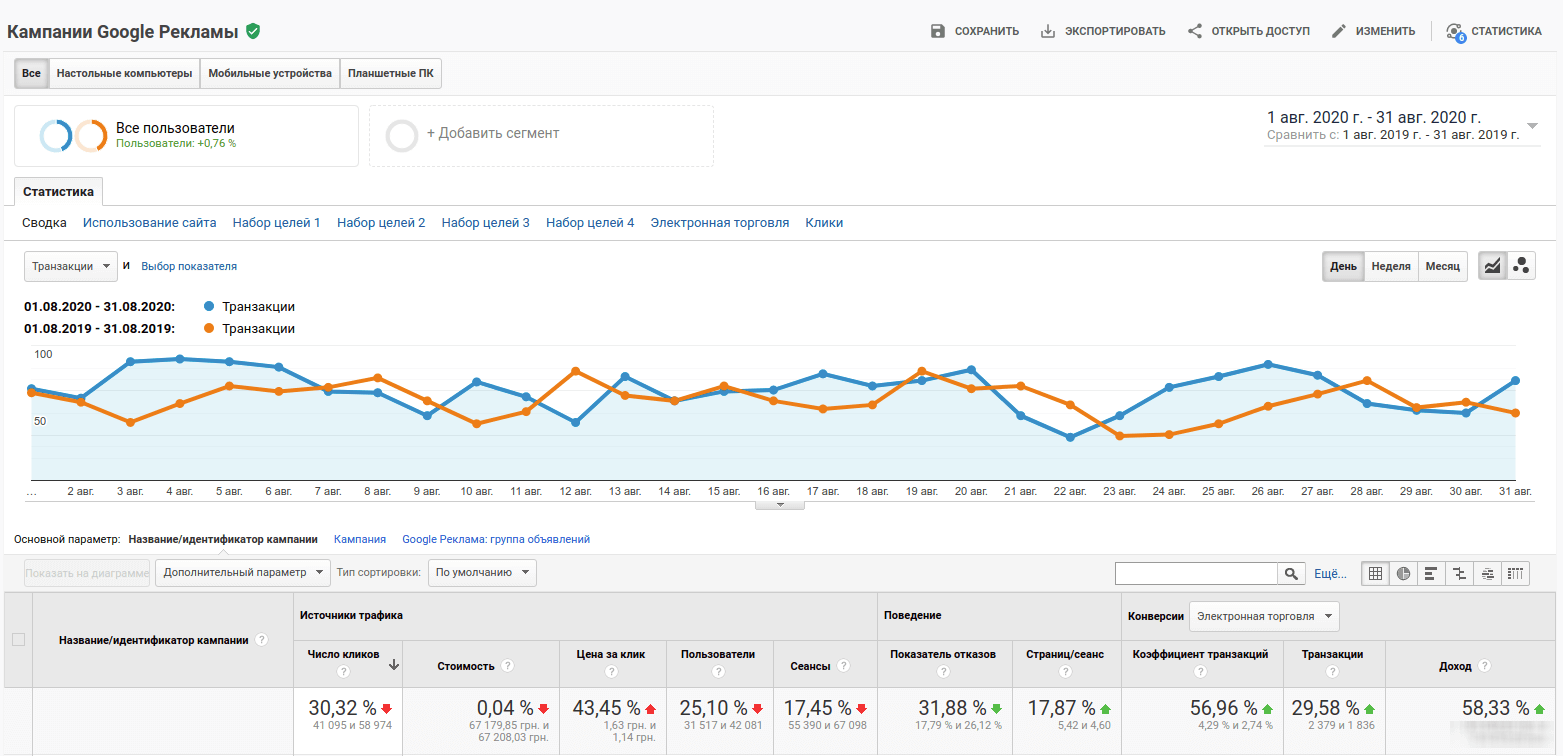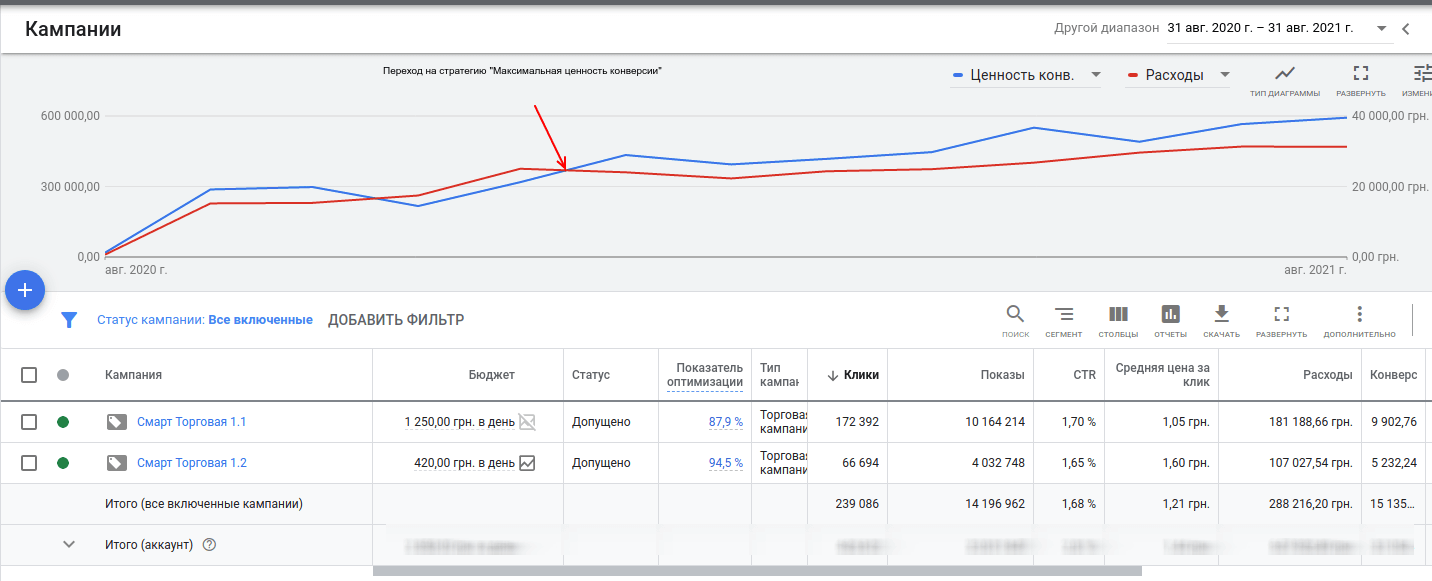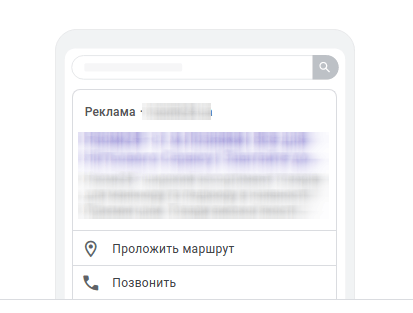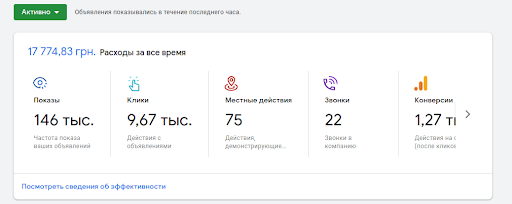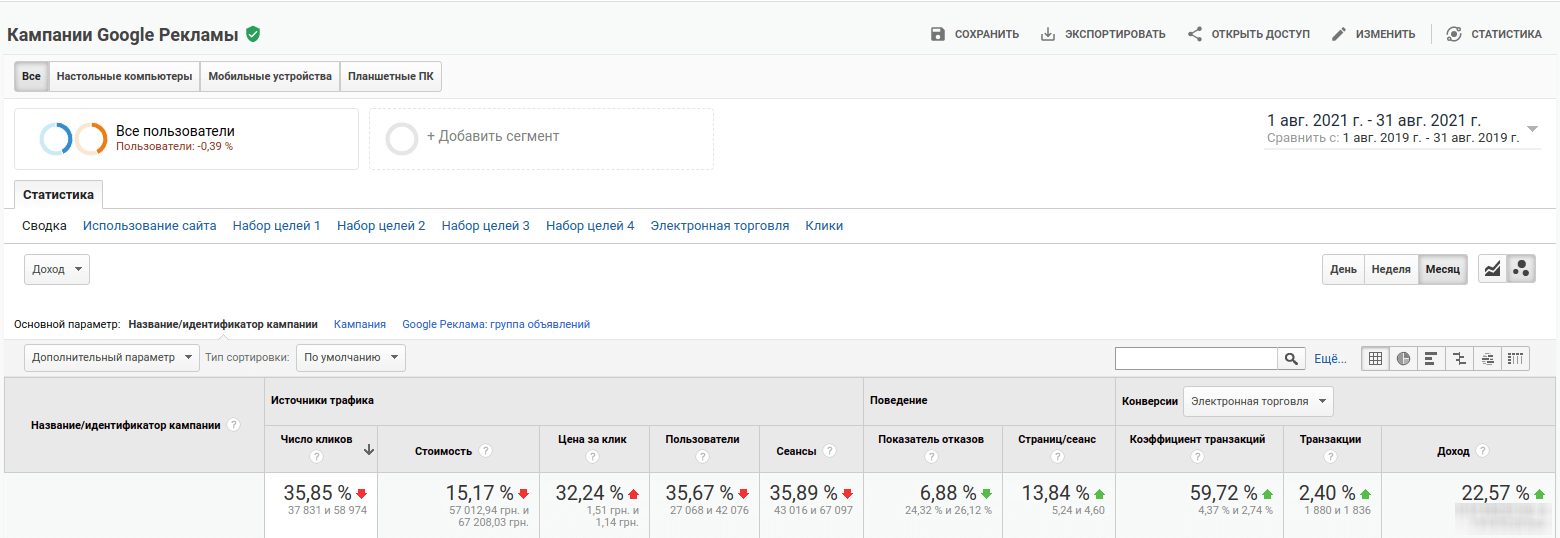*with a 15.17% decrease in the click budget
Client
Online cosmetics and manicure products shop with a network of offline shops in Kyiv. Macro-level customer base is divided into two parts: B2C (small average check, mostly one-time purchases for personal use) and B2B (wholesale orders from salons and masters, with a high average check and LTV).
Period of work
Work on the project is ongoing from 01/07/2019 to the present.
Our task
Since any business is a living organism, constantly changing under the influence of external factors, in 2 years the original objective from the client “To increase sales” was transformed into a more complex but financially effective objective — to maximize advertising revenue.
Description of work
Over such a long period of work on the project, we have accumulated many interesting statements, and it is virtually impossible (we tried) to describe them all in one story. Therefore, we decided to share the most significant and interesting aspects. Conventionally, all work on the project can be divided into 3 periods, each of which had a different impact on the final result of promotion.
Period I — the start of the project
At the time of launch, the client was already running contextual advertising campaigns on Google. After the audit, the Aweb team prepared an account development strategy to increase conversions.
The ad campaigns in the account were set up at a high enough level, but the client was interested in growth and scaling, and for that, the global strategy needed to be reviewed, and the approach changed.
Global objectives:
- Conversion trackingThe client demonstrated a systematic approach to the business, so internal business processes were clearly regulated, all orders were recorded in CRM with the indication of the source and further tracking of traffic sources efficiency by key business indicators (LTV, CPS, CPL, AOV). On our side, we had to set up proper tracking of all types of conversions on the website (e-commerce, calls, form submissions).
- Setting up advertising campaignsTogether with the client, we prepared a list of priority product groups. The main challenge at the stage of selecting groups for launching a PPC campaign was to combine the client’s wishes with the ability to quickly achieve the goals set in the number of conversions from the PPC position.
For example: there is a product group A with which the client makes the maximum profit, and it’s natural that the client wants to increase sales in this particular group. But the volume of search queries for this group of products is minimal, so there is no traffic, so there is no way to quickly get a sufficient number of conversions through contextual advertising. At the same time, group B products, which is able to provide a significant number of conversions and is recommended by PPC experts, bring minimal profit, so it makes no sense for the client to promote this group. In the end, together we found group C, which combines both the client’s wishes and the possibilities of implementation on the side of PPC.
Advertising campaigns set up at the start of the project work:
- OptimizationBefore working with Aweb, the client had been running contextual advertising campaigns on Google Ads for a long time. As the range of the online shop is quite wide, the account contained a large volume of active advertising campaigns. Based on the results of the audit, we suspended the campaigns with low effectiveness. The campaigns that showed potential for improvement were kept active, and a plan was developed to optimize them.
Optimization and adjustment actions in the period I
We have set up 74 advertising campaigns: search, CMN, sales, and video campaigns. The main principle behind optimizing campaigns across all networks is a non-linear approach to measuring effectiveness, which consists of the following principles:
-
- accounting for conversions according to the model “Position-aware”;
- when evaluating the results of an advertising campaign, to the basic criteria (number of conversions, conversion price) we added associated conversions in the form of a coefficient for evaluating the effectiveness of a particular advertising campaign. Using this tool is a kind of “fuse” that protects against the shutdown of campaigns (mainly contextual media and video campaigns) that were bringing in direct conversions at a high cost, but at the same time, they are an intermediary for the completion of conversions in other campaigns;
- updating ad texts, and a change in the approach to creating texts: away from universal descriptions for a niche and towards targeted descriptions for a specific product category;
- transition to auto bidding strategies. It’s strange to read about this in 2021 (it’s strange to write about it too), but in 2019, auto strategies were not as popular and, in addition, did not always produce predictable results. The process of switching to auto strategies was quite lengthy because of the large number of active advertising campaigns;
- launching a Smart Shopping Campaign. A regular ad campaign on manual settings brought in almost 40% of conversions, at a fairly low cost per conversion. For the first few weeks, both the regular and smart campaigns ran in parallel. As a result, the Smart Campaign was almost 40 times more effective in terms of cost per conversion. Naturally, as the traffic volume increased, the cost per conversion also began to rise, but the Smart Campaign was still more effective;
- launching Dynamic Search Ads (DSA). For e-com projects, this is an ideal tool because it allows you to collect traffic for queries that would fall into the “Few Queries” status in a conventional search advertising campaign. In addition, the launch of such a format allows you to save time on setup, which is especially important when there are a large number of SKUs.
In addition to additional traffic, this format also reduces the price per click.
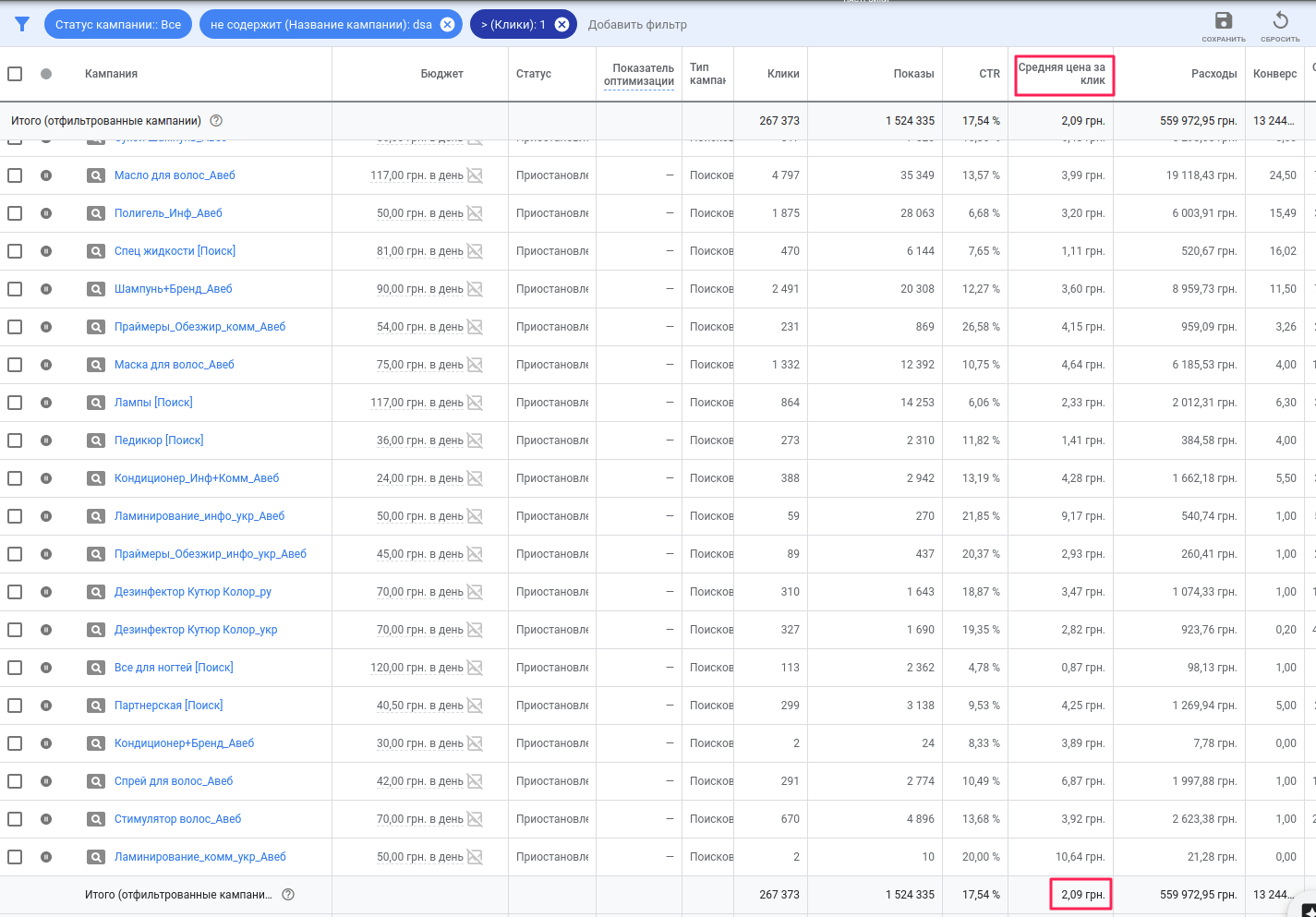
Data after the first full month of cooperation (August 2019) compared to the same period (August 2018) last year.
| Traffic by 67.43% | Transactions by 91,05% | Revenue by 42,06% |
The budget for clicks increased by 34.81%
Period II — COVID-19 pandemic, lockdown, and antiseptics
The global challenge for this period is to squeeze the most out of a fixed budget for clicks. Testing new hypotheses, launching ad campaigns in new areas, or increasing the budget for more effective ad campaigns: all within a fixed budget. Accordingly, the main task of the team is to react quickly to changes in the performance of already launched campaigns, suspend the least effective campaigns and use the released funds to either test new hypotheses or scale the already successful campaigns in the account.
Optimization
- 2020 has been a rather volatile year from the perspective of almost any business. For some, the quarantine restrictions and lockdowns were points of growth that opened up new opportunities, while for others they brought business to a complete standstill. In our case, we managed to achieve a balance: on the one hand, offline business suffered, and there was a significant decline in online, as the target customer audience (beauty salons and beauty masters) under quarantine restrictions either worked at 50% load, or did not work at all; on the other hand, the life jacket, which increased the number of transactions and almost doubled revenue — increased demand for antiseptics, which the client had in stock over 75 SKUs in varying amounts and for different purposes.
After three months of active shopping, demand started to drop a little, competitors came in, and then efficiency started to decline. Therefore, from meeting the demand for antiseptics, the task was transformed into the distribution of the budget between the priority areas in order to obtain an optimal number of conversions.
-
- Testing auto strategies: in the second period, we switched all active campaigns to auto strategies, depending on the client’s goals in relation to each category, from “Maximum conversions” to “Target ROI”.Factors that influenced the choice of this or that strategy for specific campaigns were the client’s goals: testing demand for a specific brand or category, maximizing profits from the product, increasing category turnover, and others.
- Suspending advertising campaigns with low effectiveness and reallocating the budget to more effective ones. During a period of unstable demand due to quarantine restrictions, the client was understandably reluctant to increase advertising expenditure, but understanding the importance of continuity of advertising campaigns to maintain effectiveness, the budget was not significantly reduced, allowing performance to remain at the desired level.
- In addition to those already listed, our experts carried out the following work: testing of video campaigns by cold audiences, testing of remarketing audience segments for the contextual media network, launching adaptive search and media ads, testing the effectiveness of the advertising campaign by competitors and by our own brand.
- Testing auto strategies: in the second period, we switched all active campaigns to auto strategies, depending on the client’s goals in relation to each category, from “Maximum conversions” to “Target ROI”.Factors that influenced the choice of this or that strategy for specific campaigns were the client’s goals: testing demand for a specific brand or category, maximizing profits from the product, increasing category turnover, and others.
The first month of full cooperation with the client is August 2019, and below are the statistics of CPC channel performance after one year of cooperation (August 2020):
| Traffic decreased by 30.32% | Number of transactions increased by 29.58% | Revenue increased by 58.33% |
The budget for clicks has not changed
Period IIl — switch to maximizing the return on advertising investment, finding the optimum ROAS, promoting offline outlets
The main markers of this period are maximizing advertising revenue and using contextual advertising to increase traffic to offline outlets.
As we said above, any business is a living organism, changing under the influence of external factors, and the goals change accordingly. By ensuring a steady stream of transactions and being able to accurately forecast costs and revenues from digital, the client was able to dedicate some resources to experimenting with methods to increase the profitability of advertising campaigns.
Optimization
-
-
- We split the smart shopping campaign into 2 campaigns. The main reason for this is to retain the ability to experiment with bidding strategies and product groups (such experiments in one campaign could lead to a dramatic reduction in conversions and revenue if unsuccessful).
- We switched our sales campaigns first to the Target ROI strategy and then to Maximum Conversion Value. The main reason for switching to the latter strategy was a sharp increase in costs, with revenue growth lagging behind by 23%.
-
-
-
- Together with the change of strategy in the Google Ads account, we have taken the following optimization actions:
- suspended product groups with ROAS below the break-even point;
- made adjustments to the product feed, adding optional attributes to increase the clickability of ads in shopping campaigns;
- adjusted the budget on a regular basis based on data from the Google Ads Results Planner;
- client-side adjustments were made to improve the site’s UX.
- Launch of a local ad campaign for offline shop visits. Despite quite good conversion results for the local ad campaign, the actual data on the offline shop turnover did not show sufficient growth, so we suspended the local ad campaign.
- Together with the change of strategy in the Google Ads account, we have taken the following optimization actions:
-
-
-
- Due to the low effectiveness of the Local ad campaign, we decided to test the Smart ad campaign format on two of the client’s priority offline shops. This format allows us to combine two goals: to encourage visits to the offline outlet and to push for online purchases. By integrating with Google My Business service, 2 buttons can be added to the ad: route to the offline point, call (to the number of the specific offline point, not the number of the online shop), and standard: go to the website of the online shop.
-
The statistics for this type of advertising campaign are as follows:
As a result of the successful test run of two ad campaigns, our specialists decided to scale up: today Smart ad campaigns are launched on all offline shops of the client’s network.
Results of the project in numbers (comparison of the first month of the project and data for the same period 2 years later):
Conclusions
-
-
- Transformation of business goals in the process of working on a project is a natural process. The main thing is to react quickly to changes and adjust the strategy in time, which is only possible with a constant exchange of information between the client and the agency.
- It is impossible to take a linear approach to problem-solving. If one tool does not work, you need to keep testing alternatives.
- Increasing revenue without increasing the budget for clicks is feasible (and without reducing turnover).
-
Google Ads toolkit involved in working on the project
Types of advertising campaigns:
-
-
- Search network campaigns
- Context media campaigns
- Shopping campaigns
- Smart campaigns
- Video campaigns
- Discovery campaigns
-
Ad formats:
-
-
- Expanded text ads
- Adaptive search ads
- Dynamic search ads
- Adaptive media ads
- Graphic ads
- In-stream; out-stream ads
-
Bid assignment strategies:
-
-
- Target price per conversion
- Maximum conversions
- Maximum ROI
- Target ROI
- Maximum shows
- Price per conversion optimizer
-
Project participants:
Project manager: Ekateryna Tymoshenko
PPC specialists: Halyna Lyman, Olexander Shylin
Head of the contextual advertising department: Halyna Lyman


